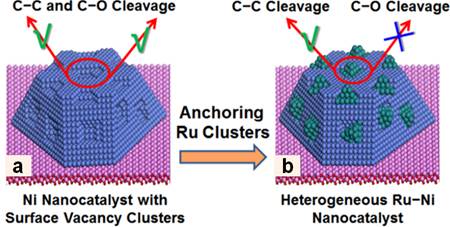| Ru-Cluster-Modified Ni Surface Defects toward Selective Bond Breaking between C-O and C-C |
| From: PublishDate:2017-06-16 Hits: |
The defect structure on the metal catalyst surface, with a large density of low-coordinated atoms and a higher-lying d state, normally enables enhanced binding of reactant molecules and serves as the active sites for heterogeneous catalysis processes. Therefore, the surface defects may dominate the reactivity of catalysts, and great efforts have been made to develop novel metal catalysts with abundant and controllable surface defects. However, for catalytic processes involving multiple reaction pathways, knowledge concerning the influence of the defect structure on catalytic selectivity is still lacking, and how to achieve largely improved selectivity via tuning the defect structure remains a challenge. A team from Beijing University of Chemical Technology has gained insight into the defect structure of Ru-Ni nanocatalyst and bond cleavage selectivity toward C-C and C-O. Their research has been published on June 13th, 2016 in Chemistry of Materials.
Figure 1. Illustration of selective bond-breaking between C-O and C-C: (a) Ni/H-Al2O3 catalyst, (b) the structured Ru-Ni/H-Al2O3 catalyst derived from the anchoring of Ru clusters onto the surface defects of Ni nanoparticles. Supported Ni nanoparticles with various concentrations of surface defects were firrst prepared by the team based on a precise control over the in situ structural topotactic transformation of NiAl-hydrotalcite precursor followed by an annealing treatment. Ni surface defects as active sites promote C?C and C?O bond cleavage simultaneously in ESR (ethanol steam reforming), but C-O bond cleavage displays a much stronger surface-defect-dependence. To inhibit the C?O bond rupture, the surface defects of Ni nanoparticles was modified by anchoring Ru clusters to control the bond-breaking selectivity. An experimental-computational combination study demonstrates that the blocking of Ni surface defects via Ru anchoring remarkably inhibits the C?O bond rupture and the resulting methanation; while the obtained catalyst with strained Ru?Ni interfacial sites effectively promotes C-C bond cleavage and consequently enhance a H2 yield. Using synchrotron radiation at BSRF, the detailed structural information of Ni and Ru for various samples was studied. The largest Debye-Waller factor but lowest coordination number and shortest Ni-Ni distance are observed for Ni/H-Al2O3, suggesting a severely distorted fcc Ni environment associated with abundant Ni defects. An annealing treatment of Ni/H-Al2O3 leads to an increased Ni-Ni coordination number but a decreased Debye-Waller factor, indicating a better crystallinity and less structural distortion for NiA500/H-Al2O3 and NiA550/H-Al2O3 samples. A slight shift of the absorption edge toward high photon energy relative to the Ru foil is observed, which indicates the existence of Ru-Ni interaction in the Ru0.8-Ni/H-Al2O3. Furthermore, the coordination number of Ru-Ni bond in Ru0.8-Ni/H-Al2O3 is smaller than that of Ru-Ru bond, confirrming the existence of Ru-Ni interfacial coordination. This work reported that the conversion of Ni surface defects to the Ru-Ni interface plays a critical role in the bond-breaking selectivity between C-O and C-C bond. Such studies on the bond-breaking selectivity via bimetallic interface modulation could become a powerful tool in the nanoscale design of new catalysts. Article: Hao Chen, Shan He,* Xingzhong Cao, Shitong Zhang, Ming Xu, Min Pu, Dangsheng Su,* Min Wei,* David G. Evans, Xue Duan,Ru-Cluster-Modi?ed Ni Surface Defects toward Selective Bond Breaking between C-O and C-C. Chem. Mater. 2016, 28, 4751-4761. |
|
|
| Chinese
- Metal-free efficient photocatalyst for stable visible water splitting——Top ten major scientific progresses in China in 2015
- The nano-resolution imaging platform was awarded the first rate prize of Beijing Science and Technology in 2014
- Beamline 1W1 of BSRF started to runoperate in the couplingparasitic mode of BEPCII
- Synthesis of High Performance Polymer Materials for Field Effect-Transistors
- Surfactant molecular aggregates in green solvents
- GIXRD has played an important role in the characterization of organic thin-film transistors
Copyright © 2011 - 2012 Beijing Synchrotron Radiation Facility


